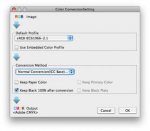I have a file with 350% tac i dark areas. Want to reduce this to 300% without changing colors.
The images in the PDF are not tagged. If I tag images using f.ex ISO Coated v2 300%, the colors will come out at 280% in the RIP-ed Proof PDF in Trueflow. But in Acrobat's Output Preview simulating Adobe CMYK it comes out as 312%. If I simulate ISO Coated 300% nothing changes. Still 350% tac.
Thanks a lot
The images in the PDF are not tagged. If I tag images using f.ex ISO Coated v2 300%, the colors will come out at 280% in the RIP-ed Proof PDF in Trueflow. But in Acrobat's Output Preview simulating Adobe CMYK it comes out as 312%. If I simulate ISO Coated 300% nothing changes. Still 350% tac.
Thanks a lot
Last edited:














